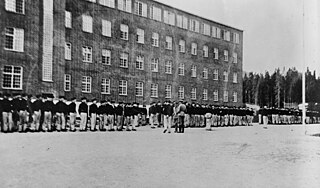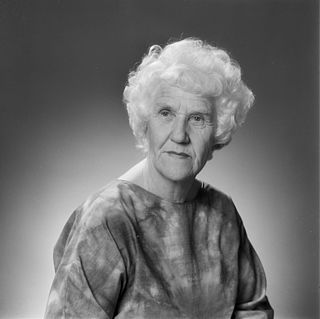
Grini prison camp was a Nazi concentration camp in Bærum, Norway, which operated between 1941 and May 1945. Ila Detention and Security Prison is now located here.

Norsk Folkemuseum, at Bygdøy, Oslo, Norway, is a museum of cultural history with extensive collections of artifacts from all social groups and all regions of the country. It also incorporates a large open-air museum with more than 150 buildings, relocated from towns and rural districts.

Kongsvoll is a historic mountain lodge built on the site of a former inn located in the Drivdalen valley in the municipality of Oppdal in Trøndelag county, Norway. The original inn dated to the 12th century. The oldest buildings of the present mountain lodge date from the 18th century.

The architecture of Norway has evolved in response to changing economic conditions, technological advances, demographic fluctuations and cultural shifts. While outside architectural influences are apparent in much of Norwegian architecture, they have often been adapted to meet Norwegian climatic conditions, including: harsh winters, high winds and, in coastal areas, salt spray.

Stephan Tschudi-Madsen was a Norwegian art historian. Tschudi-Madsen was the first antiquarian at the Norwegian Directorate for Cultural Heritage from 1959 until 1978 and was Director-general between 1978 and 1991. He was the Advisory President of the International Council on Monuments and Sites (ICOMOS) from 1981 to 1990 and ICOMOS Norway President 1978–1992.

Vestby Station is a railway station on the Østfold Line located in the village of Vestby, Norway. It is served by commuter trains operated by Vy running from Oslo to Moss. The station opened in 1879, and was modernised in the early 1990s. It features a passenger walkway built in gluelam connecting its two platforms and a small parking lot with place for approximately 120 cars. In 1950 the station served about 160 passengers to Oslo each day. Today the number are 2-3000.

Slitu Station is a railway station of the Eastern Østfold Line situated 2 kilometers (1.2 mi) south of Slitu in Eidsberg, Norway. Situated 59.33 kilometers (36.87 mi) from Oslo Central Station, it is served hourly by the L22 service of the Oslo Commuter Rail.

Kråkstad Station is a railway station located at Kråkstad in Ski, Norway. Situated 30.09 kilometers (18.70 mi) from Oslo Central Station, it is served hourly by the L22 service of Vy's Oslo Commuter Rail. The station opened on 24 November 1882 with a station building designed by Balthazar Lange in Swiss chalet style. It has been listed as a cultural heritage site. The station received a revamp in 2014. The station had 92,000 boarding and disembarking passengers in 2012.

Johannes Henrik Nissen was a Norwegian architect.

Holm Hansen Munthe was a Norwegian architect. He was a leading representative of dragon style architecture (Dragestil) which originated in Norway and was widely used principally between 1880 and 1910.
David Sandved was a Norwegian architect.

Rune Slagstad is a Norwegian historian, philosopher, legal theorist, professor and journal editor. In addition to professional work, he has since the late 1960s contributed actively to public debate on a variety of issues from Norway.

Arne Nygård-Nilssen was a Norwegian art historian, publicist and magazine editor.

Scandic Holmenkollen Park Hotel is a seminar and conference hotel in Holmenkollen in Oslo, Norway, close to Holmenkollen National Arena and Holmenkollbakken, and the Holmenkollen station of the Oslo Metro. Opened in 1894, it was designed by Balthazar Lange and is regarded as one of the prime examples of dragestil style of design and architecture in Norway.

Carsten Henrik Hopstock was a Norwegian museum curator and art historian.

Eidsvollsbygningen is a historic manor house located at Eidsvoll in Viken county, Norway. The building is where the Constitution of Norway was signed on 17 May 1814. The estate is now owned by The State of Norway and is an official national monument, as well as a museum.
Stella is a monthly Norwegian women's lifestyle magazine published by Bonnier Media which was launched on 14 March 2011. Its tagline is Indre styrke, ytre stil and its main focus is on beauty, health, fashion, and lifestyle.

Ragna Thiis Stang was a Norwegian historian and museum administrator.

The Rominten Hunting Lodge was the residence of Kaiser Wilhelm II in the Rominter Heath in East Prussia.

Harald Waldemar Bødtker was a Norwegian architect.



























